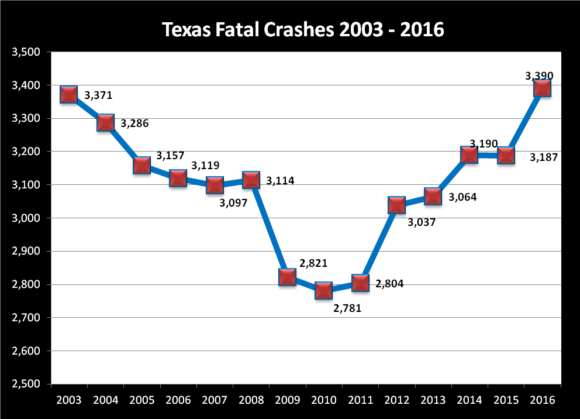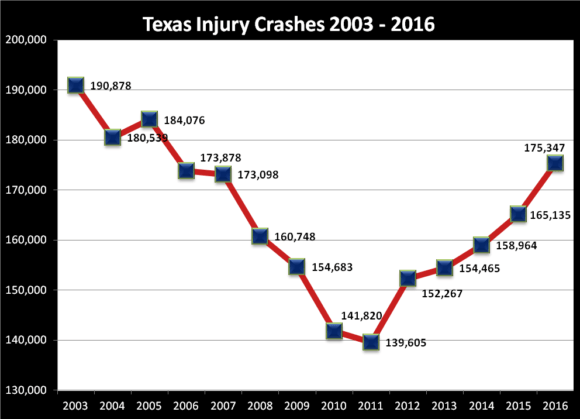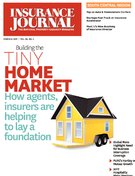Texas highways continue to be deadly, with an increase in traffic crashes involving injuries and fatalities.
Last year, 3,390 traffic crashes resulted in 3,757 fatalities and 175,347 traffic crashes resulted in 263,536 people injures, the Insurance Council of Texas reports.
The National Highway Traffic Safety Administration (NHTSA) showed Texas had the highest number of traffic fatalities of any state in 2015. The NHTSA statistics also show Texas leading the country in alcohol-impaired driving fatalities with California coming in a distant second.
The National Safety Council, a nonprofit organization founded in 1913 and chartered by Congress, has estimated that nationally as many as 40,000 people died in motor vehicle crashes in 2016. That number marks a 6 percent increase over 2015 and a 14 percent increase over 2014 — the most dramatic two-year rise in 53 years.


An estimated 4.6 million roadway users across the nation were injured seriously enough to require medical attention, a 7 percent increase over 2015.
In Texas, traffic injuries and fatalities have increased more than 20 percent in the past six years, the ICT reported. The year 2011 appears to have been a turning point, when traffic crashes ended a decades-long decline and began increasing dramatically.
Law enforcement officers say unsafe speed, alcohol, lack of seatbelt use and distracted driving are all playing a part in the state’s traffic injuries and fatalities.
Senior Police Officer Don Egdorf, of the Houston Police Department Traffic Enforcement Division, says distracted driving and impaired driving are the two biggest factors in the increase in fatal crashes.
“There are no excuses for impaired driving,” said Egdorf. “There are too many affordable options out there for anyone to drive drunk and distracted driving is just as dangerous as impaired driving.”
Texas also has higher speed limits in parts of the state, a growing population, a healthy economy and low gasoline prices. These factors place more drivers on roadways and provide more opportunities for major traffic mishaps to occur.
Nationwide, in addition to a noticeable increase in automobile passenger deaths, there has been a rise in motorcyclist, bicyclist and pedestrian fatalities. NHTSA statistics show that almost half of the automobile passengers killed were not wearing seat belts.
A survey released by the NSC on Feb. 15 shows that nationally 64 percent of drivers are comfortable speeding, 47 percent are okay texting while driving either manually or through voice controls, 13 percent admitted to driving while impaired by marijuana, and 10 percent said they have driven after drinking too much alcohol.
With the increase in crashes, there is also a corresponding need for vehicle repair and replacement, and in some cases, costly medical bills after an accident. This, along with weather related losses, has contributed to upward pressure on insurance rates in some areas of the state.
“Unfortunately, for some Texas consumers, auto insurance rates may be affected by the state’s rising number of traffic mishaps,” said Mark Hanna, a spokesperson for the Insurance Council of Texas. “Medical care after an auto accident, and repairing or replacing vehicles loaded with the latest software, may impact rates for some. Thankfully, a good driving record, taking advantage of any discounts offered by insurers, and researching the many companies who do business in Texas, will help Texans find affordable rates among the more than 100 companies that offer auto insurance in the state.”
Topics Texas Auto Personal Auto
Was this article valuable?
Here are more articles you may enjoy.


 FM Global Rebrands As FM
FM Global Rebrands As FM  Beryl’s Remnants Spawned 4 Indiana Tornadoes, Including an EF-3: NWS
Beryl’s Remnants Spawned 4 Indiana Tornadoes, Including an EF-3: NWS  Insurers Settle With Hotel in Case of Woman Videotaped in the Shower
Insurers Settle With Hotel in Case of Woman Videotaped in the Shower  Hard Market Conditions Expected to Ease in 2025 as Claims Inflation Softens: Swiss Re
Hard Market Conditions Expected to Ease in 2025 as Claims Inflation Softens: Swiss Re 


